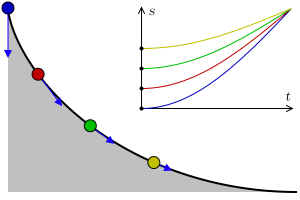Geometric interpretation of the half-derivative?
A possible mechanical interpretation of the half-derivative can be given in terms of Abel's solution to a classical problem from the calculus of variations (the tautochrone problem).
Let there be a heavy particle which is constrained to slide without friction along the curve $y=y(t)$ in uniform gravity to its lowest point. Then, given a function $T(y)$ that specifies the total time of descent for a given starting height what is an equation of the curve that yields this result?
The principle of conservation of energy implies that the distance $S=S(t)$ travelled by the particle along the curve from the initial height $y_0$ satisfies the equation $$\left(\frac{dS}{dt}\right)^2=2g(y_0-y).$$ This is equivalent to the integral equation $$T(y_0)=\frac{1}{\sqrt{2g}}\int_0^{y_0}\frac{1}{(y_0-y)^{1/2}}\frac{dS}{dy}dy.$$
The r.h.s. of the latter equation is nothing else but the Riemann–Liouville fractional integral of $f=\pi^{1/2}(2g)^{-1/2}dS/dy$, i.e. $$D^{-\alpha}f(x)=\frac{1}{\Gamma(\alpha)}\int_0^x (x-y)^{\alpha-1}f(y)dy$$ of the order $\alpha=1/2$.
The solution to Abel's integral equation $dS/dy$ can be now interpreted (up to a constant factor) as the half-derivative of $T=T(y_0)$.

A simple perspective for all fractional integro-derivative operators (FID) of this type is that they satisfy the group power sum property (law of exponents)
$$D_x^{\alpha}D_x^{\beta} = D_x^{\alpha+\beta}$$
and that their actions satisfy the dual translations
$$D_x^{\beta} \; H(x) \; \frac{x^{\alpha}}{\alpha!} = H(x) \; \frac{x^{\alpha-\beta}}{(\alpha-\beta)!} = D_x^{-\alpha-1} \; H(x) \; \frac{x^{-\beta-1}}{(-\beta-1)!} ,$$
where $H(x)$ is the Heaviside step function. This is consistent with the rep of this action as the convolutional integral rep of the Euler beta function analytically continued via the Pochhammer contour or the methods of generalized functions/distributions. See below and my response to the MO-Q "What's the matrix of logarithm of derivative operator (lnD)? What is the role of this operator in various math fields?" and the numerous links therein.
The Euler beta integral has a variety of physical, geometric, and probabilistic interpretations. See the MO-Q "Connections to physics, geometry, geometric probability theory of Euler's beta integral (function)".
Sinc function / cardinal series interpolation and a circular Fourier transform:
Let me summarize some old MO and MSE responses and blog notes for easy reference to relate the FIDs here to a Fourier transform on the circle and to hopefully clear up some confusion of this family of FIDs in fractional calculus with pseudo-diff ops/symbols related to Fourier transforms of continuous functions over the whole real line.
As mentioned above one (of several reps) for the action of the FIDs is the Euler beta integral rep
$$D_x^{\beta} \; H(x)\frac{x^{\alpha}}{\alpha!}= H(x)\int_{0}^{x}\frac{z^{\alpha}}{\alpha!} \; \frac{(x-z)^{-\beta-1}}{(-\beta-1)!}\; dz $$
$$= [ \; \int_{0}^{1}\frac{t^{\alpha}}{\alpha!} \; \frac{(1-t)^{-\beta-1}}{(-\beta-1)!} \; dt \;] \; H(x) \; x^{\alpha-\beta} .$$
Focusing on the Euler beta integral,
$$ \int_{0}^{1}\frac{t^{\alpha}}{\alpha!} \; \frac{(1-t)^{-\beta-1}}{(-\beta-1)!} \; dt $$
$$= \int_{0}^{1}\frac{t^{\alpha}}{\alpha!} \; \sum_{n=0} (-1)^n \frac{1}{n!\;(-\beta-n-1)!} \; t^n \; dt$$
$$ =\frac{1}{a! (-\beta-1)!} \sum_{n=0} (-1)^n \binom{-\beta-1}{n} \; \frac{t^{n+\alpha+1}}{n+\alpha+1} \; |_{t=0}^1$$
$$ = \frac{(-\alpha-1)!}{(-\beta-1)!}\; \sum_{n \ge 0} \binom{-\beta-1}{n}\; \frac{\sin(\pi \; (n+\alpha+1))}{\pi(n+\alpha+1)}$$
$$ = \frac{(-\alpha-1)!}{(-\beta-1)!} \; \sum_{n \ge 0} \binom{-\beta-1}{n} \; \binom{0}{n+\alpha+1} = \frac{(-\alpha-1)!}{(-\beta-1)!} \; \binom{-\beta-1}{\alpha-\beta} = \frac{1}{(\alpha-\beta)!} $$
with the last two lines valid for all complex $\alpha$ and $Re(\beta) < 0$.
A quick change of variables, reflecting the desirable property
$$D_x^{\beta} \; H(x) \; \frac{x^{\alpha}}{\alpha!} = D_x^{-\alpha-1} \; H(x) \; \frac{x^{-\beta-1}}{(-\beta-1)!} = H(x) \; \frac{x^{\alpha-\beta}}{(\alpha-\beta)!},$$
gives
$$ \int_{0}^{1}\frac{t^{\alpha}}{\alpha!}\;\frac{(1-t)^{-\beta-1}}{(-\beta-1)!}\; dt = \int_{0}^{1}\frac{(1-t)^{\alpha}}{\alpha!}\;\frac{t^{-\beta-1}}{(-\beta-1)!}\; dt ,$$
with the binomial expansion and subsequent sinc function interpolation for the RHS valid for
all complex $\beta$ and $Re(\alpha) > -1.$
Since the domains of validity of the two different avenues of expansion overlap to give the same result at their intersection, we have via analytic continuation an expression valid for all $\alpha$ and $\beta$, real or complex,
$$D_x^{\beta} \; H(x) \; \frac{x^{\alpha}}{\alpha!} = D_x^{-\alpha-1} \; H(x) \; \frac{x^{-\beta-1}}{(-\beta-1)!} = H(x) \; \frac{x^{\alpha-\beta}}{(\alpha-\beta)!},$$
with the caveat (really an operator interpretation)
$$H(x) \frac{x^{-n-1}}{(-n-1)!} = (-1)^n \delta^{(n)}(x) $$
with the standard Dirac delta interpretation
$$H(x) \int_0^x f(x-t) \; \delta(t) \; dt = H(x) \int_0^x f(t) \; \delta(x-t) \; dt = H(x) f(x).$$
A Cauchy integral rep gives the blow-up from the real line of the Euler beta integral to the complex plane, and, with a bit of regularization,
$$D_x^{\beta} \;H(x)\frac{x^{\alpha}}{\alpha!}= H(x)\frac{1}{2\pi i} \; \oint_{|z-x|=|x|}\frac{z^{\alpha}}{\alpha!} \; \frac{\beta!}{(z-x)^{\beta+1}} \;dz$$
$$ = [\; \frac{1}{2\pi i} \; \oint_{|z-1|=1}\frac{z^{\alpha}}{\alpha!} \; \frac{\beta!}{(z-1)^{\beta+1}} \;dz \;] \; H(x) \; x^{\alpha-\beta}$$
$$ = [\;\frac{1}{2 \pi} \int_{-\pi}^{\pi} (1+e^{i \theta})^{\alpha} \; e^{-i \beta \theta} d\theta \; ] \; \frac{\beta!}{\alpha!} \; H(x) \; x^{\alpha-\beta}$$
$$ = [ \; \sum_{n \geq 0} \binom{\alpha}{n} \; \frac{\sin(\pi \; (n-\beta))}{\pi(n-\beta)} \;] \; \frac{\beta!}{\alpha!} \; H(x) \; x^{\alpha-\beta} = H(x) \; \frac{x^{\alpha-\beta}}{(\alpha-\beta)!}.$$
Here, we have that the FID operation is equivalent to the Fourier transform over a circle (or an average of the Fourier transform of a periodic, in general piecewise continuous function over the real line)
$$\frac{1}{2 \pi} \int_{-\pi}^{\pi} (1+e^{i \theta})^{\alpha} \; e^{-i \beta \theta} d\theta.$$
(I recall seeing eons ago that Ramanujan explored this last integral. Anyone have a ref?)